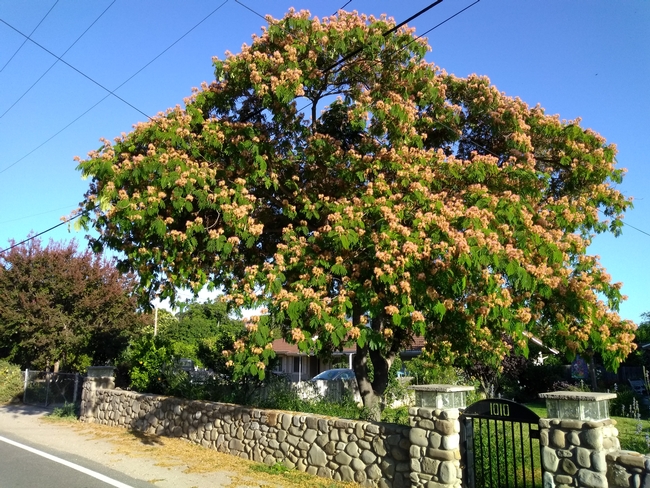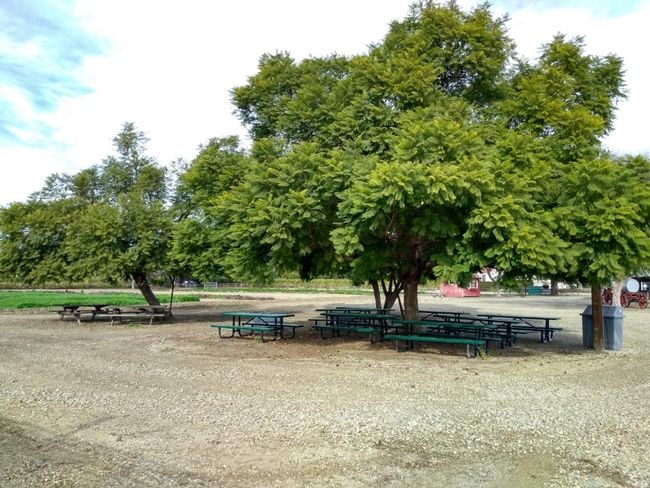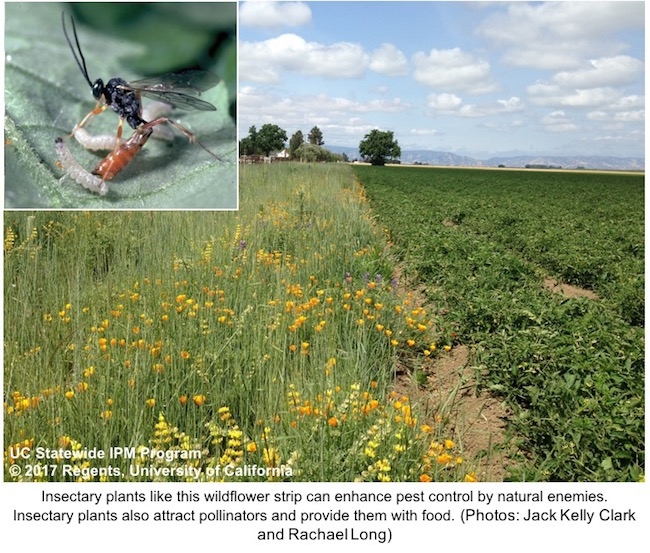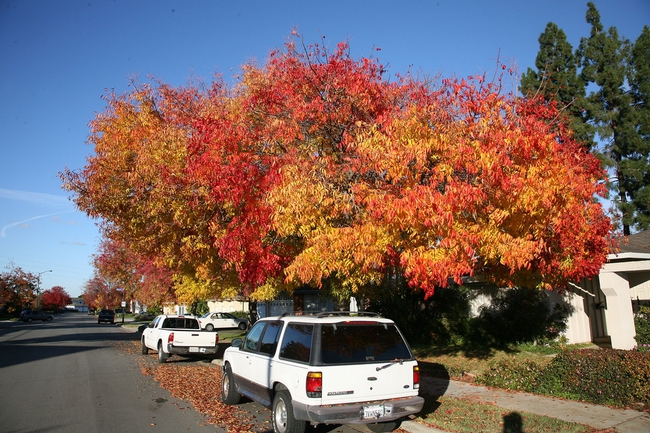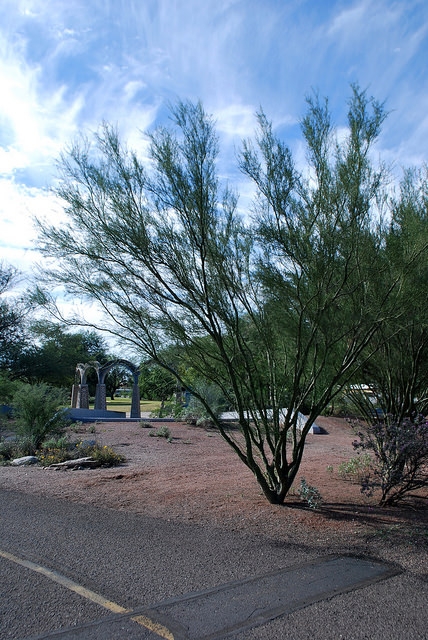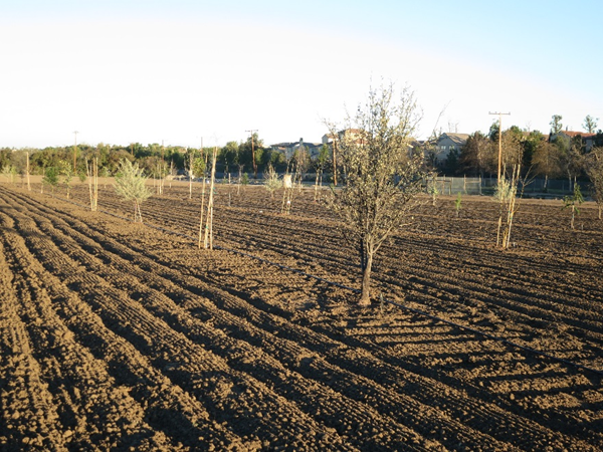Posts Tagged: Earth Day
Tree lovers invited to free webinars to learn proper tree-care
While spring may not be the best time to plant shade trees, many people are inspired to plant trees as part of Earth Day and Arbor Day celebrations. Millions of trees are planted every year in America and many of them perish after planting, according to James Downer, University of California Cooperative Extension horticulture and plant pathology advisor.
“Tree planting campaigns, while well intentioned, may not consider all the realities of bringing young trees into landscapes and caring for them over decades,” Downer said. “Increasingly, city budgets for tree care are being cut back and planting budgets are non-existent in many cities. Tree planting is left to volunteer groups, homeowners, schools and other organizations that may want trees in their communities.”
Planting is just the first step in trees' lives and can also be the reason for their demise if they are not planted correctly. Trees that survive initially may perish later in their young lives due to poor maintenance or exotic pests or from drought.
To teach members of the public how to select and care for trees, Downer will host a series of free webinars. The five one-hour sessions will cover tree selection, where and how to plant a tree, how to prune trees, how to feed and water them, and pest management. Downer, who is based in Ventura County, welcomes all tree enthusiasts.
When: Thursdays beginning April 22, 2021
Time: 12:30 – 1:30 p.m.
Registration and details at https://ucanr.edu/survey/survey.cfm?surveynumber=33331.
Schedule:
April 22: Selection of Trees (benefits of trees)
April 29: Planting Trees
May 6: Pruning Trees
May 13: Caring for Trees (mulch, water, fertilizer)
May 20: Managing tree pests and diseases
“Establishing trees starts with tree selection—planting the right tree in the right place,” Downer said. “As trees grow and begin to fill their space in gardens, landscapes, parks or city streets they begin to require other kinds of care.”
Downer, who holds a Ph.D. in plant pathology from UC Riverside, has 35 years of experience in horticulture and plant pathology. His research focuses on diseases of shade trees and other landscape plants and cultural practices to maintain landscape plants, especially trees. He also studies the use of mulch, soil microbiology and disease suppression in mulched soils.
Home is where the habitat is: This Earth Day, consider installing insectary plants
Help the environment on Earth Day, which falls on April 22, by growing insectary plants. These plants attract natural enemies such as lady beetles, lacewings, and parasitic wasps. Natural enemies provide biological pest control and can reduce the need for insecticides. Visit the new UC IPM Insectary Plants webpage to learn how to use these plants to your advantage.
The buzz about insectary plants
Biological control, or the use of natural enemies to reduce pests, is an important component of integrated pest management. Fields and orchards may miss out on this control if they do not offer sufficient habitat for natural enemies to thrive. Insectary plants (or insectaries) can change that — they feed and shelter these important insects and make the environment more favorable to them. For instance, sweet alyssum planted near lettuce fields encourages syrphid flies to lay their eggs on crops. More syrphid eggs means more syrphid larvae eating aphids, and perhaps a reduced need for insecticides. Similarly, planting cover crops like buckwheat within vineyards can attract predatory insects, spiders, and parasitic wasps, ultimately keeping leafhoppers and thrips under control.
Flowering insectaries also provide food for bees and other pollinators. There are both greater numbers and more kinds of native bees in fields with an insectary consisting of a row of native shrubs planted along the field edge (called a hedgerow). Native bees also stay in fields with these shrubs longer than they do in fields without them. Therefore, not only do insectaries attract natural enemies, but they can also boost crop pollination and help keep bees healthy.
Insectary plants may attract more pests to your plants, but the benefit is greater than the risk
The possibility of creating more pest problems has been a concern when it comes to installing insectaries. Current research shows that mature hedgerows, in particular, bring more benefits than risks. Hedgerows attract far more natural enemies than insect pests. And despite the fact that birds, rabbits, and mice find refuge in hedgerows, the presence of hedgerows neither increases animal pest problems in the field, nor crop contamination by animal-vectored pathogens. Hedgerow insectaries both benefit wildlife and help to control pests.
How can I install insectary plants?
Visit the Insectary Plants webpage to learn how to establish and manage insectary plants, and determine which types of insectaries may suit your needs and situation. If you need financial assistance to establish insectaries on your farm, consider applying for Conservation Action Plan funds from the Environmental Quality Incentives Program (EQIP) offered by the Natural Resources Conservation Service.
Sources:
- Flower flies (Syrphidae) and other biological control agents for aphids in vegetable crops. (PDF)
- Good news for hedgerows: no effects on food safety in the field.
- Hedgerow benefits align with food production and sustainability goals.
- Habitat restoration promotes pollinator persistence and colonization in intensively managed agriculture. (PDF)
- Reducing the abundance of leafhoppers and thrips in a northern California organic vineyard through maintenance of full season floral diversity with summer cover crops.
Earth Day history can inspire us all
My father was ahead of his time.
Years before Americans were asked to, Jim Hayden ensured that our family conserved energy by keeping the thermostat low, turning off lights and taking "military" showers to reduce water use. My father also observed the speed limit. Our family vacations took us to national parks. I grew up with a keen appreciation for the outdoors. I remember the sense of horror and helplessness when I saw the images of distressed wildlife in the aftermath of the Santa Barbara oil spill, which devastated the beaches that were an important part of our family's life.
In part as a result of that oil spill, Earth Day came into being. And 49 years after that inaugural Earth Day event, many of us will find ourselves at a gathering dedicated to increasing awareness of the environment that supports and sustains us all.
History of Earth Day
Earth Day was launched in 1970. Many factors contributed to the call for a national day focusing on environmental stewardship, including the publication of Rachel Carson's Silent Spring - serialized in the New Yorker - and the catastrophic oil spill that occurred off the coast of Santa Barbara in 1969. The Santa Barbara oil spill galvanized U.S. Senator Gaylord Nelson (D-Wisconsin) to call for a national day of locally inspired and organized "teach-ins" on the environment - a national "Earth Day." The Earth Day model was inspired by the spirit of campus activism at the nation's colleges and universities. It wasn't top-down, but rather a grassroots effort that encouraged communities to develop educational and service events around issues and topics important to them.
Earth Day struck a chord; some estimates suggest that 1 in 10 Americans participated in the first events. Earth Day is widely credited with "sparking" the modern environmental movement. Landmark environmental legislation swiftly followed (including the Clean Air Act, Clean Water Act and Endangered Species Act). The Environmental Protection agency was founded that same year. Twenty years after its launch, Earth Day became a global movement.
You can learn more from the Earth Day Network by linking to this website.
Take part. Learn. Act.
UC ANR research efforts support a healthy and sustainable environment
UC ANR is dedicated to supporting a healthy and sustainable environment. It's part of our core mission. Highlighted below are just a few of the many projects we're working on to protect California's natural resources, build climate-resilient communities and ecosystems, and promote healthy people and communities.
Seeking Street Trees that Can Cope With Climate Change
Trees play a vital role in shading and beautifying California's urban areas. UC ANR researcher Janet Hartin says that:
“Urban areas create heat islands, with dark asphalt surfaces reradiating heat. Cities can be 10 to 20 degrees warmer than the surrounding environment."
Trees provide other benefits, including improving soil health and stability, providing habitat for wildlife and serving as a source of beauty. But climate change (resulting in reduced rainfall and higher temperatures) can create chronic stress in some street tree species.
To find a solution, UC Cooperative Extension scientists are partnering with the U.S. Forest Service "in an unprecedented 20-year research study to expand the palette of drought-adapted, climate-ready trees for several of the state's climate zones."
“The idea is to look at available but under-planted, drought-tolerant, structurally sound, pest resistant trees for Southern California that do well in even warmer climates,” said Janet Hartin, UCCE horticulture advisor in San Bernardino County.
Learn more - including what tree species might be planted in your area - in this terrific read by Jeannette Warnert.
CDFA and UC ANR join forces to advance Climate-Smart Ag
A new partnership between the California Department of Food and Agriculture (CDFA) and UCANR aims to advance climate-smart ag in California. More than $1 million has been used to hire 10 UC Cooperative Extension community education specialists, who are being deployed to 10 counties to help farmers participate in CDFA programs that increase the adopting of "smart" farming and ranching practices.
The primary focus is putting into action on-farm solutions to improve (and increase) smart farming practices that reduce greenhouse gas emissions. Practices that improve soil health, nutrient management, irrigation management, and more will be emphasized.
Learn more about this innovative program here.
Be kind to the Earth by reducing food waste
Nearly 40 percent of the food produced in the U.S. is wasted and much of that waste ends up in landfills (definitely not good for our environment or the economy). The National Resources Defense Council estimates that the average family of four throws out nearly 1,000 pounds of food each year, wasting roughly $1,500. Consumers as a group waste more food than farms, grocery stores or restaurants. For tips on ways you can reduce #FoodWaste, click here. Related Reading: What a World War I Poster Can Teach Us About #FoodWaste.
4-H Sustainable You! summer camp to be offered in Ventura County
The UCCE Ventura County team will once again be hosting its week-long 4-H Sustainable You! summer day camp at UC's Hansen Agricultural Research and Extension Center (HAREC) in Santa Paula. Campers aged 9-12 are invited to spend time on a working farm, learning what it means to be sustainable through fun activities based around the five major themes: Air, Land, Energy, Water, and Food. Registration information can be found here.
For more than 100 years the UC ANR 4-H Youth Development Program has taught generations of California children about food, agriculture, leadership, and community service using learn-by-doing practices. The California 4-H Science, Engineering and Technology (STEM) Initiative seeks to increase science literacy and help address the growing need for scientists, engineers, and technical experts. 4-H empowers youth with the skills to lead for a lifetime.
Interested in learning more about 4-H in your community? Visit our statewide 4-H program page.
The above photo is one of my favorites. It was taken by Apollo 8 astronaut Bill Anders on Dec. 24, 1968, while in orbit around the moon. It shows the Earth rising for the third time above the lunar horizon. It always serves to remind me that my individual actions do matter, and when considered with the actions of others, contribute to real change ... the "moon shot." Have a great Earth Day!
Take part. Learn. Act. Earth Day is Sunday, April 22
Earth Day has roots in California, stemming in part from an oil spill off the coast of Santa Barbara in 1969, wrote Rose Hayden Smith in a UC Food Observer post marking the 48th annual Earth Day this Sunday, April 22.
"The Santa Barbara oil spill galvanized U.S. Senator Gaylord Nelson (D-Wisconsin) to call for a national day of locally inspired and organized 'teach-ins' on the environment – a national 'Earth Day,'" the story says. The first Earth Day was April 22, 1970.
Earth Day is widely credited with “sparking” the modern environmental movement. Landmark environmental legislation swiftly followed (including the Clean Air Act, Clean Water Act and Endangered Species Act). The Environmental Protection agency was founded that same year. Twenty years after its launch, Earth Day became a global movement.
Among the stories covered in the UC Food Observer is a UC Cooperative Extension research project that is seeking to identify street trees that can cope with rising temperatures and lower rainfall expected due to climate change. UCCE scientists are partnering with the U.S. Forest Service “in an unprecedented 20-year research study to expand the palette of drought-adapted, climate-ready trees for several of the state's climate zones."
Read more about the project here.
The UC IPM program is encouraging Californians to celebrate Earth Day by growing insectary plants. These plants attract natural enemies such as lady beetles, lacewings, and parasitic wasps. Natural enemies provide biological pest control and can reduce the need for insecticides.
UC study seeks street trees that can cope with climate change
The changing climate predicted for California – including less rain and higher day and nighttime temperatures – is expected to cause chronic stress on many street tree species that have shaded and beautified urban areas for decades.
Realizing that popular trees may not thrive under the changing conditions, UC Cooperative Extension scientists are partnering with the U.S. Forest Service in an unprecedented 20-year research study to expand the palette of drought-adapted, climate-ready trees for several of the state's climate zones.
“The idea is to look at available but under-planted, drought-tolerant, structurally sound, pest resistant trees for Southern California that do well in even warmer climates,” said Janet Hartin, UCCE horticulture advisor in San Bernardino County.
Hartin, a 34-year veteran advisor, said the project is her first to stretch to 20 years; it will likely extend past her tenure with UCCE.
“I'd like to retire in five or six years,” she said. “But I'm very excited about being a pioneer in a study that will continue with my successors. I think it's important for our children and our children's children, as well as for the environment.”
At the end of 2019, with three years of data on tree health and growth rates, the scientists expect to be able to publish the first results and make them available to arborists, urban foresters and residents throughout the regions of the study.
Twelve tree species were selected for each climate zone in the comparative study, with several area parks used as control sites. Hartin and her Southern California research collaborators – UCCE advisors Darren Haver of Orange County and Jim Downer of Ventura County – worked closely with UC Davis plant biologist Alison Berry, UC Davis research associate Greg McPherson and USFS research urban ecologist Natalie van Doorn to select promising species.
They looked for trees that are already available at local nurseries, but are underutilized. The trees in the project exhibit drought tolerance and disease resistance, plus produce minimal litter. The researchers also sought trees that would provide ample cooling shade for a long time – ideally 50 years or longer.
The varieties come from areas around the world with climates similar to California. Two trees planted in replicated plots at the UC Riverside Citrus Field Station are native to Australia, two are native to Oklahoma and Texas, one is native to Asia and two are non-native crosses of other trees. Three of the trees are native to California: the netleaf hackberry, Catalina cherry and island oak.
“Trees are a long-term investment,” Hartin said. “A tree will live 50, 70, 90 years. The proper selection is very important to help ensure longevity.”
Making the long-term investment with the proper selection yields considerable returns. In a warming world, trees are natural air conditioners.
“Urban areas create heat islands, with dark asphalt surfaces reradiating heat. Cities can be 10 to 20 degrees warmer than the surrounding environment,” Hartin said.
Other tree benefits include soil health and stability, wildlife habitat and aesthetic beauty.
Following are a sampling of trees that are part of the comparative study:
Acacia – A 20-foot-tall, 20-foot wide evergreen that is drought resistant, and withstands moderate irrigation. Native of Australia.
Blue palo verde – A tree that reaches about 25 feet in height, the Blue palo verde is drought resistance and lives 50 to 150 years. Its trunk, branches and leaves have a blue-green hue. Native to the southwestern U.S. and Mexico.
Brazilian cedarwood – A native of Brazil and Paraguay, the deciduous tree grows to 50 to 65 feet. The tree produces pale yellow tubular flowers in the spring.
Catalina cherry – Native to the chaparral areas of coastal California, the Catalina cherry grows to 30 feet high. The evergreen tree tolerates drought when mature. It produces sweet purple-to-black edible fruit.
Chinese pistache – A deciduous tree with beautiful fall color. Grows to 35 feet tall, 30 feet wide. Drought resistant, but tolerates moist soil. Native to central and western China.
Desert willow – Growing to 30 feet tall and living 40 to 150 years, the desert willow tolerates highly alkaline soil and some salinity. A deciduous tree, it boasts large pink flowers all summer that attract hummingbirds and other wildlife. Native to the southwestern U.S. and northern Mexico.
Escarpment live oak – Native to west Texas, this tree is cold hardy and drought tolerant. Typically evergreen, it can be deciduous in colder climates.
Ghost gum – Very tall at maturity and drought tolerant. An Australia native.
Indian laurel – Commonly called a ficus, this is a 35-foot-tall, 35-foot-wide tree at maturity that is drought resistant and tolerates highly alkaline and saline soils. Shade potential is high. Native of Asia and Hawaii.
Ironwood – A southwestern and northern Mexico native, Ironwood is semi-drought resistant once mature and tolerates alkaline soil. Ironwood, which grows to about 33 feet tall, can live 50 to 150 years.
Island oak – This tree is native to five of six California off-shore islands. Drought tolerant, it grows to nearly 70 feet tall when mature.
Maverick mesquite – Native to the southwestern U.S. and northern Mexico, this tree does well in full sun and is drought resistant once established. The tree grows to 35 feet tall. The Maverick mesquite is a thornless variety.
Mulga – A versatile and hardy tree that grows 15 to 20 feet in height, the mulga – a Western Australia native – tolerates hot and dry conditions. The leaves are evergreen and the tree has yellow elongated fluffy flowers in spring.
Netleaf hackberry – A California native, the netleaf hackberry grows to 30 feet. Its deep root systems and heat resistance makes the tree idea for urban conditions.
Rosewood – Native to southern Iran, Indian rosewood grows to 65 feet tall, and 40 feet wide. Evergreen. Semi drought resistant and intolerant of alkaline soil.
Shoestring Acacia – Evergreen and 30 feet tall when mature, shoestring acacia is drought resistant and thrives in slightly acidic to highly alkaline soils. Native to Australia.
Tecate cypress – A native of Southern California and Mexico, the Tecate cypress is very drought tolerant. Its foliage is bright green. Young trees are pyramidal in shape, becoming more rounded or contorted with age.
Partners in the tree study are Los Angeles Beautification Team volunteers, LA Parks and Recreation team, Chino Basin Water Conservation District, and Mountain States Wholesale Nursery.
Funding and other support is provided by LA Center for Urban Natural Resources Sustainability, ISA Western Chapter, Britton Fund, USFS Pacific Southwest Research Station, and the UC system.

